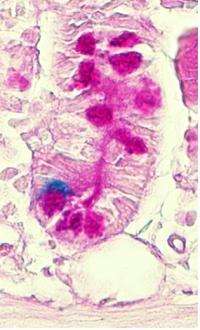Tales from the crypt: Study on gut cell regeneration reconciles long-standing research controversy

The cells that help to absorb food and liquid that humans consume are constantly being produced. The various cell types that do this come from stem cells that reside deep in the inner recesses of the accordion-like folds of the intestines, called villi and crypts. But exactly where the most important stem cell type is located -- and how to identify it -- has been something of a mystery.
The lining of the intestine regenerates itself every few days as compared to say red blood cells that turn over every four months. The cells that help to absorb food and liquid that humans consume are constantly being produced. The various cell types that do this come from stem cells that reside deep in the inner recesses of the accordion-like folds of the intestines, called villi and crypts.
But exactly where the most important stem cell type is located -- and how to identify it -- has been something of a mystery. In fact, two types of intestinal stem cells have been proposed to exist but the relationship between them has been unclear. One type of stem cell divides slowly and resides at the sides of intestinal crypts. The other divides much more quickly and resides at the bottom of the crypts.
Some researchers have been proponents of one type of stem cell or the other as the "true" intestinal stem cell. Recent work published this week in Science from the lab of Jonathan Epstein, MD, chairman of the Department of Cell and Developmental Biology from the Perelman School of Medicine at the University of Pennsylvania, may reconcile this controversy. The findings suggest that these two types of stem cells are related. In fact, each can produce the other, which surprised the researchers.
"We actually began our studies by looking at stem cells in the heart and other organs," Epstein said. "In other tissues in the body, slowly dividing cells can sometimes give rise to more rapidly dividing stem cells that are called to action when tissue regeneration is required. Our finding that this can happen in reverse in the intestine was not expected."
The discovery that rapidly cycling gut stem cells can regenerate the quiescent stem cells -- slowly dividing and probably long-lived -- suggests that the developmental pathways in human organs that regenerate quickly like in the gut, skin, blood, and bone, may be more flexible than previously appreciated.
"This better appreciation and understanding may help us learn how to promote the regeneration of tissue-specific adult stem cells that could subsequently help with tissue regeneration," says Epstein. "It may also help us to understand the cell types that give rise to cancer in the colon and stomach."















